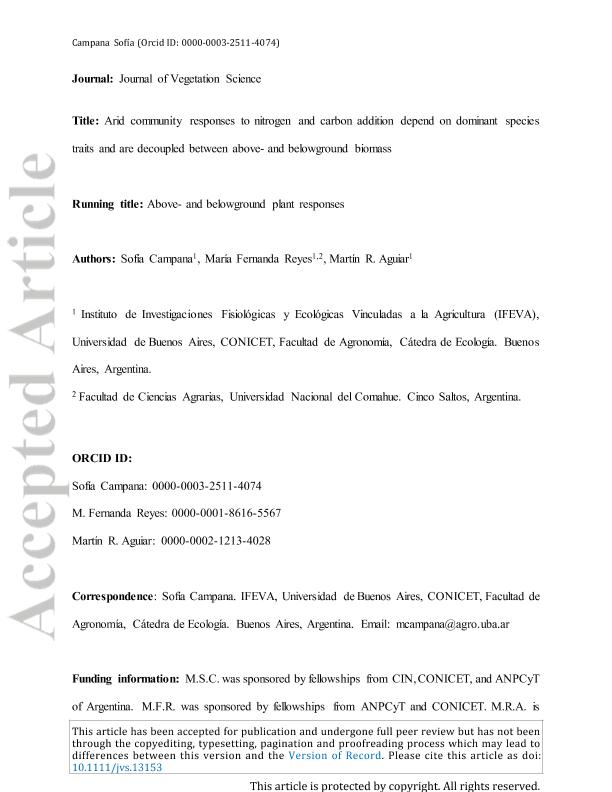Mostrar el registro sencillo del ítem
dc.contributor.author
Campana, María Sofía

dc.contributor.author
Reyes, María Fernanda

dc.contributor.author
Aguiar, Martin Roberto

dc.date.available
2023-11-01T17:56:14Z
dc.date.issued
2022-09
dc.identifier.citation
Campana, María Sofía; Reyes, María Fernanda; Aguiar, Martin Roberto; Arid community responses to nitrogen and carbon addition depend on dominant species traits and are decoupled between above- and below-ground biomass; Wiley Blackwell Publishing, Inc; Journal of Vegetation Science; 33; 5; 9-2022; 1-8
dc.identifier.issn
1100-9233
dc.identifier.uri
http://hdl.handle.net/11336/216793
dc.description.abstract
Questions: Arid communities are strongly limited by soil resources including water and nitrogen (N). Plants compete for N with other plants and microorganisms, which are also limited by carbon (C). We propose that above- and below-ground plant responses to soil resources are modulated by community structure (species relative abundances, “mass ratio hypothesis”) and species traits (relative growth rates — RGRs). We evaluated the single and combined effects of soil N and C addition on the above- and below-ground biomass accumulation of perennial grass patches in an arid community, and the mechanisms involved in their responses. Location: Patagonian steppe, Argentina. Methods: We added N (2 g N m−2; NH4NO3) and C (330 g C m−2; sucrose) to 1-m2 field plots in a factorial design. After two years, we harvested above-ground (n = 5 plots) and below-ground biomass (n = 10 soil cores) and sorted it by species. We measured potential soil respiration as a proxy of microbial activity. Results: Total above-ground biomass increased by 55% as a result of N and decreased by 45% as a result of C addition, in relation to controls. C addition reduced total below-ground biomass by 42%. The above-ground differences were associated with changes in the biomass of dominant species according to their RGRs. Poa ligularis (dominant, high RGR) increased by 92% as a result of N addition while Pappostipa speciosa (dominant, low RGR) decreased by 55% as a result of C addition. Intermediate and subordinate grasses did not modify their biomass, independently of their RGR. Potential soil respiration was three times higher in plots with C addition than in control plots. Conclusions: Community biomass was explained by a combination of mass ratio hypothesis and specific RGR, as dominant grasses controlled above-ground community responses to N (high-RGR species) and C addition (low-RGR species). Our findings highlight the independence between the above- and below-ground processes and the importance of considering community equitability and species characteristics to predict plant community responses to changes in soil resources.
dc.format
application/pdf
dc.language.iso
eng
dc.publisher
Wiley Blackwell Publishing, Inc

dc.rights
info:eu-repo/semantics/openAccess
dc.rights.uri
https://creativecommons.org/licenses/by-nc-sa/2.5/ar/
dc.subject
BIOMASS ACCUMULATION
dc.subject
DOMINANT SPECIES
dc.subject
MASS RATIO HYPOTHESIS
dc.subject
PATAGONIAN STEPPE
dc.subject
PERENNIAL GRASSES
dc.subject
POTENTIAL SOIL RESPIRATION
dc.subject
RELATIVE GROWTH RATES (RGR)
dc.subject
SUBORDINATE SPECIES
dc.subject.classification
Ecología

dc.subject.classification
Ciencias Biológicas

dc.subject.classification
CIENCIAS NATURALES Y EXACTAS

dc.title
Arid community responses to nitrogen and carbon addition depend on dominant species traits and are decoupled between above- and below-ground biomass
dc.type
info:eu-repo/semantics/article
dc.type
info:ar-repo/semantics/artículo
dc.type
info:eu-repo/semantics/publishedVersion
dc.date.updated
2023-11-01T12:04:21Z
dc.journal.volume
33
dc.journal.number
5
dc.journal.pagination
1-8
dc.journal.pais
Reino Unido

dc.journal.ciudad
Londres
dc.description.fil
Fil: Campana, María Sofía. Consejo Nacional de Investigaciones Científicas y Técnicas. Oficina de Coordinación Administrativa Parque Centenario. Instituto de Investigaciones Fisiológicas y Ecológicas Vinculadas a la Agricultura. Universidad de Buenos Aires. Facultad de Agronomía. Instituto de Investigaciones Fisiológicas y Ecológicas Vinculadas a la Agricultura; Argentina
dc.description.fil
Fil: Reyes, María Fernanda. Consejo Nacional de Investigaciones Científicas y Técnicas. Oficina de Coordinación Administrativa Parque Centenario. Instituto de Investigaciones Fisiológicas y Ecológicas Vinculadas a la Agricultura. Universidad de Buenos Aires. Facultad de Agronomía. Instituto de Investigaciones Fisiológicas y Ecológicas Vinculadas a la Agricultura; Argentina
dc.description.fil
Fil: Aguiar, Martin Roberto. Consejo Nacional de Investigaciones Científicas y Técnicas. Oficina de Coordinación Administrativa Parque Centenario. Instituto de Investigaciones Fisiológicas y Ecológicas Vinculadas a la Agricultura. Universidad de Buenos Aires. Facultad de Agronomía. Instituto de Investigaciones Fisiológicas y Ecológicas Vinculadas a la Agricultura; Argentina
dc.journal.title
Journal of Vegetation Science

dc.relation.alternativeid
info:eu-repo/semantics/altIdentifier/url/https://onlinelibrary.wiley.com/doi/10.1111/jvs.13153
dc.relation.alternativeid
info:eu-repo/semantics/altIdentifier/doi/http://dx.doi.org/10.1111/jvs.13153
Archivos asociados
